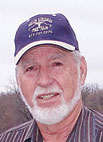
Livestock agriculture has many niches. One of these is the smaller scale operations that provide supplementary retirement income and, as importantly, significant daily activity. Danny Frye, a two-year railroad retiree and current small-scale farmer said, “I am busy all of the time because there is always something to do. Farming keeps me constantly moving.” In response, Danny’s wife Lois, who is the Southwest City, Mo., court and city clerk quipped, “Yes, but sometimes he’s asleep when I leave for work and that’s just wrong.”
The couple, now married for 50 years, first bought land in Southwest City in the late 1960s with Lois and their growing family settling on the land in the early 1980s after traveling for years with Danny. Lois said, “When I first moved here I thought it was the most god-forsaken place I’d ever been. Now I wouldn’t live anywhere else.” The Fryes own 300 acres with another 55 off-site. The land is used for raising cows and goats and for haying.
The cattle herd currently consists of 45 mixed breed mommas and two bulls, one Red Angus and one Limousin. The purpose of the Red Angus is to provide an easier birthing weight for the heifers and reduced pasture consumption, which is of great help during droughts. The Limousin influence provides better muscling, a characteristic of the Limousin breed.
When the drought came, Danny sold some of his older cows and bought heifers because they ate less. Danny buys and sells most of his bred heifers although he tends to keep heifers from his good, old cows believing doing so will improve the genetics of his base herd.
Danny uses liquid lick or tubs of lick in the winter and sweet magnesium, salt and medicated mineral that kills fly larva in the summer. He also provides calves with creep feed all year round because some mothers don’t produce enough milk and because the process bunk breaks the calves early which results in an easier and, according to Lois, a less noisy weaning.
Danny said, “I used to administer all of my own shots but I may not do so anymore.” Danny found that when he had the sale barn veterinarian administer shots before the sale, Danny’s animals tended to bring a slightly higher price. He credits this to the fact that the veterinarian told buyers he knew the animals had been treated because he did it himself. Danny likes the ease and results of the new process and plans to continue following it.
In 1984, the Frye spread had acres of dense briars and purchased 12 just weaned brush goats. Unfortunately they lost six very quickly because they didn’t understand that the goats needed black leg shots.
Later as the goats cleared the briars, the Fryes began transitioning to Boer meat goats. The mostly Boer herd now consists of 32 ewes.
One of the challenges with the goats is having enough pens for the new mothers so each mother and her young can have a separate pen to become accustomed to being together. Sometimes the nannies don’t want to nurse and need to be forced. The pen system makes that process much simpler. Also, if the newborns are left with the herd, the mothers will sometimes fight or leave them in the field. The bottom line is that the size of their goat herd is determined by the number of sheltered pens their facility can accommodate.
Danny hays 200 acres and last year put up 700 large bales. To keep his fields productive, Danny spot sprays for thistle and dock weed and uses commercial fertilizer because litter is no longer as easily available. Danny said, “Going slow is the secret to harvesting hay. I use the five mile-per-hour rule because the ground is so rough with rock and stump holes.”
Danny also has 7 acres of alfalfa because he likes how it looks. Danny said, “Our field is a novelty and a topic of conversation around here.” The biggest challenge with his alfalfa field is army worms which he sprays for as needed. All of Danny’s fields are treeless in order to maximize both land and moisture usage.







